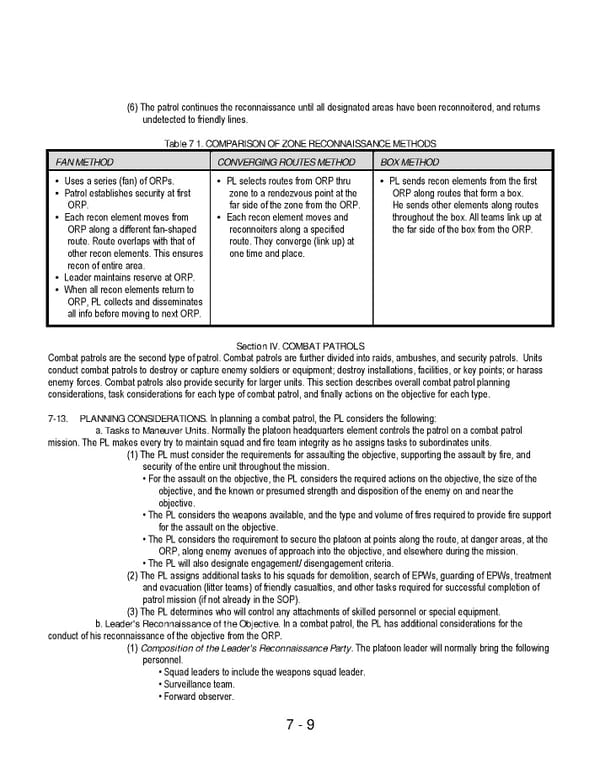7 - 9 (6) The patrol continues the reconnaissance until all designated areas have been reconnoitered, and returns undetected to friendly lines. Table 7 1. COMPARISON OF ZONE RECONNAISSANCE METHODS FAN METHOD CONVERGING ROUTES METHOD BOX METHOD • Uses a series (fan) of ORPs. • Patrol establishes security at first ORP. • Each recon element moves from ORP along a different fan-shaped route. Route overlaps with that of other recon elements. This ensures recon of entire area. • Leader maintains reserve at ORP. • When all recon elements return to ORP, PL collects and disseminates all info before moving to next ORP. • PL selects routes from ORP thru zone to a rendezvous point at the far side of the zone from the ORP. • Each recon element moves and reconnoiters along a specified route. They converge (link up) at one time and place. • PL sends recon elements from the first ORP along routes that form a box. He sends other elements along routes throughout the box. All teams link up at the far side of the box from the ORP. Section IV. COMBAT PATROLS Combat patrols are the second type of patrol. Combat patrols are further divided into raids, ambushes, and security patrols. Units conduct combat patrols to destroy or capture enemy soldiers or equipment; destroy installations, facilities, or key points; or harass enemy forces. Combat patrols also provide security for larger units. This section describes overall combat patrol planning considerations, task considerations for each type of combat patrol, and finally actions on the objective for each type. 7-13. PLANNING CONSIDERATIONS. In planning a combat patrol, the PL considers the following: a. Tasks to Maneuver Units. Normally the platoon headquarters element controls the patrol on a combat patrol mission. The PL makes every try to maintain squad and fire team integrity as he assigns tasks to subordinates units. (1) The PL must consider the requirements for assaulting the objective, supporting the assault by fire, and security of the entire unit throughout the mission. • For the assault on the objective, the PL considers the required actions on the objective, the size of the objective, and the known or presumed strength and disposition of the enemy on and near the objective. • The PL considers the weapons available, and the type and volume of fires required to provide fire support for the assault on the objective. • The PL considers the requirement to secure the platoon at points along the route, at danger areas, at the ORP, along enemy avenues of approach into the objective, and elsewhere during the mission. • The PL will also designate engagement/ disengagement criteria. (2) The PL assigns additional tasks to his squads for demolition, search of EPWs, guarding of EPWs, treatment and evacuation (litter teams) of friendly casualties, and other tasks required for successful completion of patrol mission (if not already in the SOP). (3) The PL determines who will control any attachments of skilled personnel or special equipment. b. Leader's Reconnaissance of the Objective. In a combat patrol, the PL has additional considerations for the conduct of his reconnaissance of the objective from the ORP. (1) Composition of the Leader's Reconnaissance Party. The platoon leader will normally bring the following personnel. • Squad leaders to include the weapons squad leader. • Surveillance team. • Forward observer.
 Ranger Handbook Page 120 Page 122
Ranger Handbook Page 120 Page 122